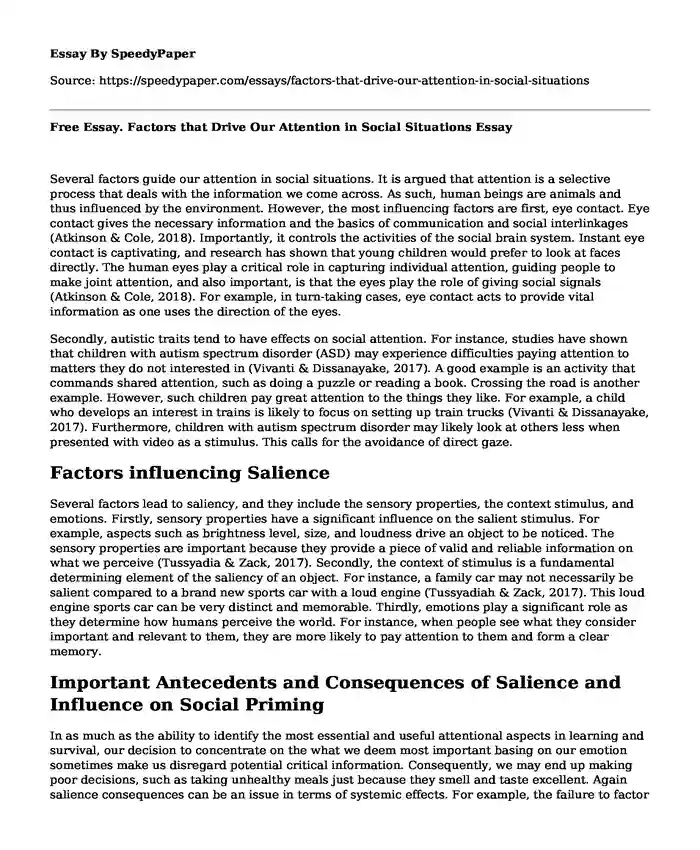
| Type of paper: | Essay |
| Categories: | Autism Interpersonal communication |
| Pages: | 3 |
| Wordcount: | 682 words |
Several factors guide our attention in social situations. It is argued that attention is a selective process that deals with the information we come across. As such, human beings are animals and thus influenced by the environment. However, the most influencing factors are first, eye contact. Eye contact gives the necessary information and the basics of communication and social interlinkages (Atkinson & Cole, 2018). Importantly, it controls the activities of the social brain system. Instant eye contact is captivating, and research has shown that young children would prefer to look at faces directly. The human eyes play a critical role in capturing individual attention, guiding people to make joint attention, and also important, is that the eyes play the role of giving social signals (Atkinson & Cole, 2018). For example, in turn-taking cases, eye contact acts to provide vital information as one uses the direction of the eyes.
Secondly, autistic traits tend to have effects on social attention. For instance, studies have shown that children with autism spectrum disorder (ASD) may experience difficulties paying attention to matters they do not interested in (Vivanti & Dissanayake, 2017). A good example is an activity that commands shared attention, such as doing a puzzle or reading a book. Crossing the road is another example. However, such children pay great attention to the things they like. For example, a child who develops an interest in trains is likely to focus on setting up train trucks (Vivanti & Dissanayake, 2017). Furthermore, children with autism spectrum disorder may likely look at others less when presented with video as a stimulus. This calls for the avoidance of direct gaze.
Factors influencing Salience
Several factors lead to saliency, and they include the sensory properties, the context stimulus, and emotions. Firstly, sensory properties have a significant influence on the salient stimulus. For example, aspects such as brightness level, size, and loudness drive an object to be noticed. The sensory properties are important because they provide a piece of valid and reliable information on what we perceive (Tussyadia & Zack, 2017). Secondly, the context of stimulus is a fundamental determining element of the saliency of an object. For instance, a family car may not necessarily be salient compared to a brand new sports car with a loud engine (Tussyadiah & Zack, 2017). This loud engine sports car can be very distinct and memorable. Thirdly, emotions play a significant role as they determine how humans perceive the world. For instance, when people see what they consider important and relevant to them, they are more likely to pay attention to them and form a clear memory.
Important Antecedents and Consequences of Salience and Influence on Social Priming
In as much as the ability to identify the most essential and useful attentional aspects in learning and survival, our decision to concentrate on the what we deem most important basing on our emotion sometimes make us disregard potential critical information. Consequently, we may end up making poor decisions, such as taking unhealthy meals just because they smell and taste excellent. Again salience consequences can be an issue in terms of systemic effects. For example, the failure to factor less salient business aspects may lead to a commitment of glaring business errors and delays (Tussyadiah & Zach, 2017). These errors may further influence the administrative duties and lead to poor business operations. This controls the social priming because salience bias emerges from the contrast between items and their environment. Considerably, salience bias is established from psychological activities like cognitive ease and our likings towards particular aspects of human operations and the general relations.
References
Atkinson, M. A., Simpson, A. A., & Cole, G. G. (2018). Visual attention and action: How cueing, direct mapping, and social interactions drive orienting. Psychonomic Bulletin & Review, 25(5), 1585-1605.
Tussyadiah, I. P., & Zach, F. (2017). Identifying salient attributes of peer-to-peer accommodation experience. Journal of Travel & Tourism Marketing, 34(5), 636-652.
Vivanti, G., Fanning, P. A., Hocking, D. R., Sievers, S., & Dissanayake, C. (2017). Social attention, joint attention, and sustained attention in autism Spectrum disorder and Williams syndrome: convergences and divergences. Journal of autism and developmental disorders, 47(6), 1866-1877.
Cite this page
Free Essay. Factors that Drive Our Attention in Social Situations. (2023, Nov 24). Retrieved from https://speedypaper.net/essays/factors-that-drive-our-attention-in-social-situations
Request Removal
If you are the original author of this essay and no longer wish to have it published on the SpeedyPaper website, please click below to request its removal:
- Essay Sample Highlighting Business Negotiation Process in a Multicultural Context
- What Are the Impacts of Long-distance Relationships on Interpersonal Communication? Essay Sample
- Free Essay Example on Psychosocial Problems
- Paper Example. Service Error Recovery Strategy
- Digital Dementia: New Health Epidemic Affecting Brain Function - Essay Sample
- Essay Sample. Research and Qualitative Study of Mental Illness in Prison
- Free Essay Example - Alcohol Abuse Intervention Program
Popular categories




